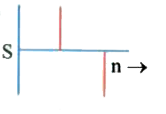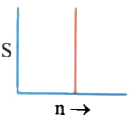The graph between distance between source and observer and apparent frequency in the case of Doppler's effect will be




The correct Answer is:D
To solve the problem of determining the relationship between the distance between the source and observer and the apparent frequency in the case of the Doppler effect, we can follow these steps:
1. Understand the Doppler Effect:
The Doppler effect describes how the frequency of a wave changes for an observer moving relative to the source of the wave. When the source and observer are moving towards each other, the observed frequency increases, and when they are moving apart, the observed frequency decreases.
2. Identify the Variables:
- Let f0 be the actual frequency emitted by the source.
- Let v be the speed of sound in the medium.
- Let vo be the speed of the observer.
- Let vs be the speed of the source.
- Let d be the distance between the source and the observer.
3. Apparent Frequency Formula:
The apparent frequency f′ can be expressed using the formula:
f′=f0v+vov−vs
- If the source is stationary (vs=0), the formula simplifies to:
f′=f0v+vov
4. Distance Independence:
The key point here is that the apparent frequency f′ does not depend on the distance d between the source and the observer. Instead, it depends on their relative velocities. Thus, as the distance changes, the apparent frequency remains constant if the speeds of the source and observer do not change.
5. Graph Representation:
When plotting the graph of distance d (on the x-axis) versus apparent frequency f′ (on the y-axis), since f′ remains constant regardless of d, the graph will be a horizontal line. This indicates that as the distance between the source and observer increases or decreases, the apparent frequency does not change.
Conclusion:
The graph between the distance between the source and observer and the apparent frequency in the case of the Doppler effect will be a horizontal line, indicating that the apparent frequency is independent of the distance.
---
The Doppler effect describes how the frequency of a wave changes for an observer moving relative to the source of the wave. When the source and observer are moving towards each other, the observed frequency increases, and when they are moving apart, the observed frequency decreases.
- Let f0 be the actual frequency emitted by the source.
- Let v be the speed of sound in the medium.
- Let vo be the speed of the observer.
- Let vs be the speed of the source.
- Let d be the distance between the source and the observer.
The apparent frequency f′ can be expressed using the formula:
f′=f0v+vov−vs
- If the source is stationary (vs=0), the formula simplifies to:
f′=f0v+vov
The key point here is that the apparent frequency f′ does not depend on the distance d between the source and the observer. Instead, it depends on their relative velocities. Thus, as the distance changes, the apparent frequency remains constant if the speeds of the source and observer do not change.
When plotting the graph of distance d (on the x-axis) versus apparent frequency f′ (on the y-axis), since f′ remains constant regardless of d, the graph will be a horizontal line. This indicates that as the distance between the source and observer increases or decreases, the apparent frequency does not change.
The graph between the distance between the source and observer and the apparent frequency in the case of the Doppler effect will be a horizontal line, indicating that the apparent frequency is independent of the distance.
Topper's Solved these Questions
- WAVESBOOK - NARAYNACHAPTER - WAVESEXERCISE - Exercise-II (H.W)
17 Videos
- WAVESBOOK - NARAYNACHAPTER - WAVESEXERCISE - Exercise-III
56 Videos
- WAVESBOOK - NARAYNACHAPTER - WAVESEXERCISE - Exercise-I (H.W)
101 Videos
- VECTORSBOOK - NARAYNACHAPTER - VECTORSEXERCISE - LEVEL-II (H.W)
14 Videos
- WORK , ENERGY & POWER BOOK - NARAYNACHAPTER - WORK , ENERGY & POWER EXERCISE - EXERCISE IV
43 Videos
Similar Questions
A : In Doppler's effect the value of apparent frequency depends on the relative motion between source and observer .
R : The change in frequency in Doppler effect is independent from the distance between source and observer .
View Solution(a) Does the change in frequency due to Doppler effect depend on the distance between source (b)Does the change in frequency due to Doppler effect on the fact that source is moving towards the observer or observer is moving towards the source ?
View Solution
Knowledge Check
Change in frequency due to Doppler's effect is produced when
Athe source and the observer are moving in the same directionBthe source and the observe are both at restCthere is a relative motion between the source and the observerDthere is a resultant motion between the source and observer.The graph between inductive reactance and frequency is
AparabolaBstraight lineChyperbolaDan arc of a circleAssertion : A sound source is approaching towards a stationary observer along the tine joining them. Then , apparent frequency to the observer will go on increasing.
Reason : If there is no relative motion between source and observer , apparent frequency is equal to the actual frequency.AIf both Asseration and Reason are true an dthe Reason is correct explanation of the Asseration.BIf both Asseration and Reason are true but Reason is not the correct explanation of Asseration.CIf Asseration is true , but the Reason is false.DIf Asseration is false but the Reason is true.
The change in frequency due to Doppler effect does not depend on
View SolutionDoppler's effect in sound takes place when source and observer are
View SolutionThere will be no change in frequency or no Doppler effect if
View SolutionThe change in frequency due to Doppler effect does not depend on
View SolutionDoppler's effect is sound in addition of relative velocity between source and observer, also depends while source and abserver or both are moving. Doppler effect in light depend only on the relative velocity of source and observed. The reason of this is
View Solution
